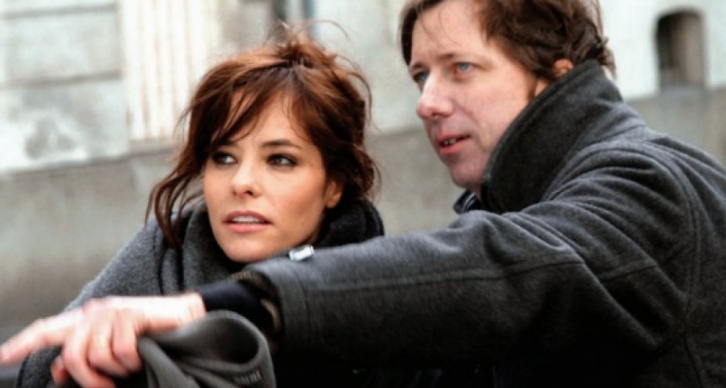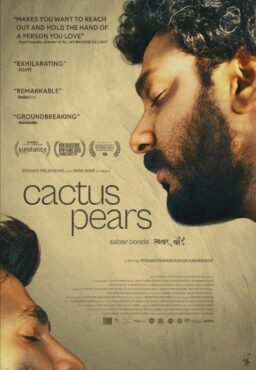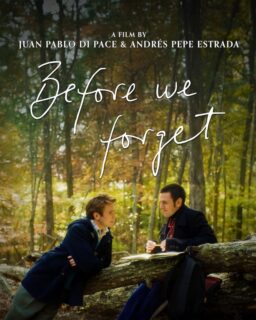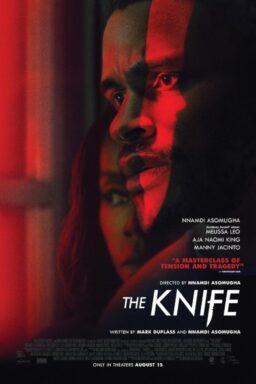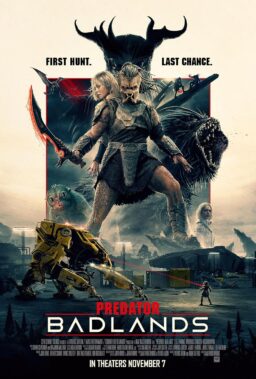For almost 20 years, people have been asking “What happened to Hal Hartley?” But the acclaimed independent director of such unsung ’90s classics like “The Unbelievable Truth,” “Trust,” and “Henry Fool” never actually went away. He directed some theater, made plenty of music, served as a visiting lecturer at Harvard, and, of course, continued to make personal, uncompromised films. His unique, rigorous style was fully formed when he burst onto the independent film scene in the early ’90s and he’s only developed it during the interim 30 years. Hartley remains one of American cinema’s foremost chroniclers of wayward malaise; his existential portraits foreground their artifice while plumbing genuine emotional depths. His indelible characters are embittered romantics who encompass a bevy of contradictions: they’re sincere and ironic, passionate but apathetic, principled yet inevitably compromised. In other words, they’re true human beings.
In 2011, Hartley successfully raised over $50,000 in a Kickstarter campaign to manufacture and release DVDs of his one-hour feature “Meanwhile.” Since then, he has used Kickstarter to fund his 2014 feature “Ned Rifle,” the third in the “Henry Fool” trilogy, as well as restore and release boxed sets of his work. Most recently, Hartley successfully raised $372,000 to fund his next feature “Where To Land.” He has remained a true independent filmmaker.
Starting on Friday, January 24, the Metrograph Theater in New York City will run a full retrospective of Hartley’s work. RogerEbert.com spoke with Hartley on the phone about a wide variety of topics: his crowdfunding experiences, his Modernist influences, suburban portraiture, distributor relations, the inherent difficulty of working for corporations, and how re-watching one’s work can help overcome dark nights of the soul.

First of all, congrats on your latest successful Kickstarter campaign.
Thank you. We’re very pleased.
You’ve been using Kickstarter to fund your work since 2011. How have you codified the process of crowdfunding over the past decade?
The first time we did it, I didn’t know what we were doing. It worked. It was for a lot less money than we raised this time. I think about it just like a production. We work for a couple months prior to the 30-day campaign and we produce video and music content and all kinds of art and text. I prepare for it as though I’m going to be entertaining people for 30 days. Sometimes I even compare it to being the producer of a local television news show or a radio show. Every day at 2 o’clock, you’ve got a ten-minute piece you’ve got to get up on air. That’s what it feels like during the 30 days. As soon as we post an update to everybody and follow it up with the various social media, we sit down and start thinking about the next day’s update. It really is like a news show.
Resources like Kickstarter are great, but they are, necessarily, a gamble. You’ve had such success, but why do you think the barrier of entry is so high for other independent filmmakers to use it?
I’ve done it five or six times now. I know who the core audience is. Maybe it was good that in the beginning I did one only for $40,000 to make “Meanwhile” into DVD’s that can be sold. That worked well, but more importantly, through that exercise I began to get a real, concrete grasp of where and who my audience is. We followed that up with a new feature and the restorations for the old films. This last Kickstarter, we really built it on that knowledge. There are certain people who always come back to the Kickstarter and buy things from HalHartley.com. I have to think that Kickstarter backer pool as my core audience, so that at least gives me an idea of about how much I can go out for. The people at Kickstarter are very thorough about that when you’re setting up your campaign. They want you to succeed because they won’t succeed if you don’t succeed. They really want to know, “Is this doable? $300,000, that’s a big number.” They pointed out that very few film-related projects on Kickstarter ever get above the $200,000 number. I said, “Yeah, I know, it’s a big number, but it is the number I need. Based on my other Kickstarters and the amount of people we have who are returning donors and stuff like that, I think it’s likely.” It is a bit of a gamble, but in this case, we far, far exceeded it. We got $72,000 more than we set out to get.
Another big thing, and this is very important, is the subtitling. Learning now that these days subtitling your film on Blu-ray in four or five languages isn’t the incredibly big expense it was back in the ’90s. It’s all digital now. We operate in Japanese, French, German, Spanish, and English. Even the website, we have essays and stuff like that, we get them translated so people from all over the world can go to HalHartley.com and read those in their language.
How do you come up with the number for the campaign? How do you game out the budget?
We come at it from a couple different directions. The first thing is just that I’ve made a lot of films so I know what things cost, so I just do a straight-ahead budget and then I compare that to what I think I might be able to raise from the audience around the world. Then you have to coincide those two scenarios. That’s no different than we ever did it. Even when back in the ’90s, when distributors were pre-buying the rights to your film. You’d take 20%, generally, from each distributor around the world and then you go to a bank and get the whole budget cash flowed with this money from the distributors as collateral. Then you’d have to figure what you can reasonably make the film for. Distributors would tell you, “We can only give you $50,000 for a seven-year license for Germany because we really don’t think we’re going to be able to make more than $100,000 or $150,000 in Germany on a film of this nature.” So you listen. You listen to your French distributor and your Australian distributor and all that, and then you have to make a call.
For me, it’s always been important that my films earn money. I don’t like it if a film gets made, we spend the money and the time, and it doesn’t do good for my partners.
I’ve been re-watching a lot of your work in preparation for this interview. One thing I find really interesting is that your films can theoretically be described or reverse-engineered by its influences—Jean-Luc Godard, Robert Bresson, Howard Hawks—but doing so would necessarily negate your own distinct voice that rises out of them each time. How would you characterize this voice that comes through?
A lot of it has to do with the way I write dialogue. I like the way different kinds of people talk, and how they sort of think while they’re talking. I like the music of dialogue, so specificity, but I like to indicate place and time. All of those people you mentioned, even Hawks, are Modernists. They allow the construction of the thing to be seen and felt. Ever since I was starting out in my 20s, I felt drawn to that kind of work. That might be it. My voice probably grew through a collision between European Modernism and a kind of local American-style dialogue and banter. I mean, Hawks and [Preston] Sturges I watched very closely, and really felt like I was learning how to make compelling, funny dialogue scenes that moved. I remember feeling that even when I was in college.
I think many people would characterize your sensibility as a distinctly ’90s one, but I feel like the free-floating disaffection and malaise that permeates your films is pretty evergreen, if not downright timely. I’m curious if you feel your interests and concerns have become more en vogue over time?
I always remind myself that I don’t need to disguise place and time of a story and what the movie is. That means everything: how people dress, what the environment looks like, and also what the culture feels like. This malaise that you’re talking about, my films are critical in that regard, I do want them, even if it’s not perfectly obvious or upfront, to indicate what the world is like at that particular time. That’s been kind of consistent with me since I started making films. I don’t really think the world has really changed that much from the ’80s to now. My personal dissatisfactions with the world are kind of regular. {Laughs.] And my enthusiasms about the world, they’ve attenuated a little as I’ve gotten older and experienced different things. I think they’re pretty much the same too.

I was watching “Henry Fool” before I got on the phone and Kevin Corrigan’s whole campaign for the reactionary congressman feels ripped from today’s headlines.
Yeah, I know. It’s useful to be reminded that nothing really changes that much. I was just reading “A New History of the United States” and I had to stop halfway through because they’re talking about the 1850’s, and I said, “This is just like now. Exactly just like now.”
I’ve always been fascinated by your portraiture of the suburbs and how it’s always gone against the tired stereotypes that have been perpetrated by film. You don’t necessarily characterize it as a comforting space, but any sense of foreboding or paranoia is tempered by a strong sense of community. You grew up in Long Island, and I assume shooting there early in your career was as much a practical decision as it was a creative one, but how conscious were you of depicting the landscape as it is versus molding it to create your own world?
The literal landscape I didn’t really want to change. I wanted to show it for what it was. I do have this Modernist tendency to sculpt some things. I think in the early films, “The Unbelievable Truth” and “Trust,” the way I shot, for instance, the trains. If you grew up in that part of Long Island, that was really your lifeline to everything, to civilization, because it led directly into New York City. But for me, I always saw it as a Western type thing. Whenever I filmed the elevated train station, the LIRR, it always had the sensibility of being in a Western film. I didn’t change anything, but the manner in which I looked at things might have reached back to other idioms, different kinds of storytelling, different kind of art.
You’ve been composing your own soundtracks since the early ’90s. How do you approach making music for a feature? Do you start before shooting or do ideas percolate during filming?
This past decade, a lot of the music can start before I make the film. I don’t really build the music into the film until after it’s cut. In the past decade, I’ve made music more regularly when I’m not making a film. All through the ’90s and the early-’00s, I only really got the instruments out of their cases when I was editing the movie. That’s when I made music. But since about 2010, I always have them out in the studio and I make music anyway. I don’t think of it particular to the film, but when I start editing, I’ll take time out and see what I’ve been doing. Sometimes I have hours of material that just need to be adjusted and fit to the film.
Who were your big musical influences growing up?
As a little kid, it was just whatever was on the radio. Mostly The Beatles, the Rolling Stones, the Supremes. My mother liked to sing The Supremes. But it was all about whatever was on the radio. Later, in college and after college, I was very influenced by the Talking Heads, whatever David Byrne was doing. During high school, it was all English progressive rock. Some glam rock.

I want to talk about “No Such Thing” for a little bit. Correct me if I’m wrong, but I feel like that film was positioned to catapult you into another stratosphere of your career, and its relative failure has seemed to dictate the next twenty years of your career. What do you think happened with the industry and audience reception of that film, and how would you characterize it two decades later?
I’ve had misgivings about that whole thing. Not the film, just the way we got it financed right from the start. I was planning on making a smaller film with a company in Iceland, and then their money plan fell apart. At the time, I had just met Francis Coppola. I was still looking for other ways to finance it as a strictly independent film like my previous one. I had called it Francis to ask advice about special effects makeup because I had liked the way he had treated Gary Oldman’s makeup in “Dracula.” I just happened to get him on the phone at a time when he had just signed a deal with United Artists to produce ten “independent films” under his executive producership. So he said, “What are you doing? Let me read the script because maybe it can be one of these films.” He said, “Having your name attached to it would really give it the street cred it needed for being independent.” I did and it took a little while, it wasn’t as hard as I thought to negotiate things, but right from the very start I just didn’t like working with a studio and corporations. Everything just went wrong. I’m very happy with the film. They didn’t know what to do with it and didn’t like it and they just kind of dumped it.
The business failure of “No Such Thing” was not the reason why I veered off and did other kinds of work. I was moving away from the business for a little while anyway even before that. Really after “Henry Fool” I was trying to do other things. You know, theater, music. I’ve always been saddened that “No Such Thing” didn’t get seen by more people, or at least just be put out well. Even those DVDs they put out stunk. I just wouldn’t work with a big corporation like that again.
How was the Cannes screening?
It was a full house and people were laughing. They applauded and all that. There was a party after. It was what you’d usually expect. But, you know, I could tell when I got out of the theater and went to the party there weren’t going to be serious business with it. For one thing, there were independent distributors in Europe who had always distributed my films. I remember this company in the Netherlands, they wanted the film for the Netherlands, they walked right into the office at Cannes for United Artists and said, “We’ve had all of Hal’s films in the Netherlands since 1990. We’ve done well, we’ve done well for him. What do you want for this film?” Then [United Artists] went through some book and they pointed at a number and said, “That’ll be a million dollars up front. That’s a minimum guarantee.” They said, “For the Netherlands? What are you talking about? We’ve never paid more than $50,000 for one of Hal’s films, but we always make money and he makes money from us.” They were like, “No, that’s it. We don’t negotiate.”
That’s crazy.
That’s the real mechanism of how films get a flat tire and never get out into the world if you make it for a corporation like that. They’re just selling product. It can be anything.
Have you changed how you prep a film from when you first started? Are your modes of production pretty much the same?
Well, there are some changes. When I was younger, I felt the need to rehearse. I’d rent a rehearsal hall for a month prior to shooting and we’d read through the scenes and we’d get the scenes up on their front and make some discoveries, but most of it was I wanted to learn how to talk to actors better and more clearly. By the end of the ’90s, I didn’t have to do that anymore. I had the confidence and I knew what I wanted to do, but we never needed to go into a rehearsal hall. That’s one big thing.
But otherwise I think it’s kind of similar to how anybody makes films. You cast, you budget, you cast again, you budget more, you go location scouting. I’d say for the past ten years one thing that I really enjoy doing in terms of production is not dressing. I like to spend a lot of time location scouting so that I find locations are close to perfect for what I need so we don’t have a big art department come in and dress it. That makes it a different kind of film. I think “Meanwhile” is a very good example of that. There was no dressing. We just found these real locations and then we design the shot down to what’s really there. I find that very satisfying creatively.

Are you still in contact with Michael Spiller? [Spiller worked as the D.P. for every Hartley film through “No Such Thing.”]
I am! I talk to him all the time.
Was there any reason why he stopped shooting your films?
He was talking about making the move into directing for years. He was shooting “Sex and the City” all the time. He was the principal D.P. on that. The directors would change and sometimes they’d fall through and eventually the producers asked Mike if he would step in and direct an episode. He liked that very much, and Mike is a very good director and producer. He thinks very well. It’s one of the reasons why he’s a such a good D.P., he can see everybody’s point of view. He’s a very good communicator, which is something you have to do a lot when you’re directing. When I started directing TV, he was the first person I called. When I got hired to direct “Red Oaks,” I said, “Yes!” but then I got terrified and thought, “Uh oh. I’m working for another corporation.” So I called Mike and asked him if he thought I could do this. He said, “Shut up. Of course you can do this!”
I was a big fan of “Red Oaks.” What was your experience working on that show?
It was, in fact, a lovely experience. Those scripts were well understood and well crafted. Greg Jacobs, whose show it was, he was my assistant director on “Amateur” and “Simple Men” back in the ’90s, so I knew him and he trusted me. He knew that I knew what I was doing. It was also great just to have all that resource. I mean, real serious funding. A half-hour episode had more than what I’m making a movie with. You had real top-notch technicians. A really great cast, too. I don’t know who the casting agency it was, I think they were in Los Angeles, but by the time I came on, they were all there. Gina [Gershon] and Paul Reiser. It was just terrific.
Didn’t you have a series in the works for Amazon?
Well, they optioned it. They were happy with my work on “Red Oaks” and just asked me, “You must have something of your own.” I said, “Oh, I got plenty of things.” I showed them one that I was excited about and they got excited by that and optioned it for two years. Ultimately, they didn’t want to do it, but they paid me very well.
If you had the opportunity, would you do with a show with someone like Amazon?
Yeah. I’ve learned a little from my “No Such Thing” experience. Actually, I learned a lot from my Amazon experience with the option period. I’ve just got to be a bit pushier. I don’t have to be as obliging. I think back with Francis Coppola, because he’s Francis Coppola, I felt, “Aw, I should be very obliging,” but in fact I got fucked.
Considering that Metrograph is running a full retrospective of your career, I’m curious if you ever re-watch your own work?
I do. In the past couple years, when we’ve been restoring all the stuff, you can’t avoid it. Sometimes it’s really a matter of finding yourself able to just relax and enjoy it as entertainment. Most of the time I’m looking for very particular technical things. I watched “Meanwhile” about a month ago for the first time simply out of curiosity because I hadn’t seen it, and I loved it and I was really happy and it gave me a lot of confidence when I was leading up to this new Kickstarter. There’s a lot of dark nights of the soul. Sometimes you wonder, “Why am I doing this? It’s going to kill me. Why am I making another low-budget feature film?” So it was actually very encouraging to watch “Meanwhile.”
This interview has been condensed and edited for clarity. The Hal Hartley retrospective series runs at the Metrograph Theater in New York City from January 24 to February 2. For more tickets and more information, click here.

